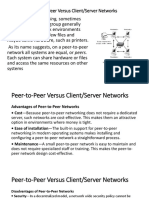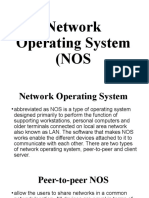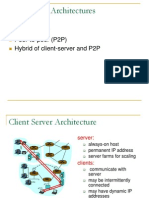0% found this document useful (0 votes)
102 views5 pagesComputer Systems Servicing
1. The document discusses network operating systems and types of networks. A network operating system allows computers on a network to share resources and functions. 2. There are two main types of networks: peer-to-peer networks and client-server networks. In a peer-to-peer network, computers connect directly and share resources without a central server. In a client-server network, a dedicated server manages resources and provides centralized storage and security. 3. The document provides details on the advantages and disadvantages of each network type to help understand their different characteristics for use in various settings.
Uploaded by
Arvie-Jay LapigCopyright
© © All Rights Reserved
We take content rights seriously. If you suspect this is your content, claim it here.
Available Formats
Download as DOCX, PDF, TXT or read online on Scribd
0% found this document useful (0 votes)
102 views5 pagesComputer Systems Servicing
1. The document discusses network operating systems and types of networks. A network operating system allows computers on a network to share resources and functions. 2. There are two main types of networks: peer-to-peer networks and client-server networks. In a peer-to-peer network, computers connect directly and share resources without a central server. In a client-server network, a dedicated server manages resources and provides centralized storage and security. 3. The document provides details on the advantages and disadvantages of each network type to help understand their different characteristics for use in various settings.
Uploaded by
Arvie-Jay LapigCopyright
© © All Rights Reserved
We take content rights seriously. If you suspect this is your content, claim it here.
Available Formats
Download as DOCX, PDF, TXT or read online on Scribd
/ 5































































































